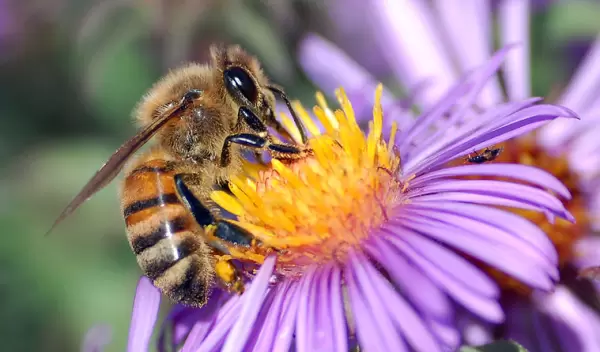
Biodiversity protects bee communities from disease, study finds
A new U.S. National Science Foundation-funded analysis of thousands of native and non-native Michigan bees shows that the most diverse bee communities have the lowest levels of three common viral pathogens.
University of Michigan researchers netted and trapped more than 4,000 bees in 60 species. The bees were collected at winter squash farms across Michigan, where managed honeybee colonies and wild native bees pollinate the squash flowers.
All but one species -- Apis mellifera, the common European honeybee -- are native bees. The number of bee species found at each farm ranged from seven to 49.
Consistently, lower virus levels were strongly linked to greater species richness among the local bee communities. The study was published in the journal Ecology.
"This result is exciting because it suggests that promoting diverse bee communities may be a win-win strategy to simultaneously reduce viral infections in managed honeybee colonies while helping to maintain native bee biodiversity," said study lead author Michelle Fearon.
"In light of recent global pollinator population declines that are due in part to the spread of pathogens, these results offer hope that conservation efforts could also broadly benefit pollinator health," said Fearon. She is now pursuing a follow-up study that explores how natural areas keep pollinator communities healthy.
The study is the first to show that high levels of biodiversity in bee communities can help dilute the harmful effects of viral pathogens. Support for this "dilution effect" has been reported in other host-pathogen systems, such as tick-borne Lyme disease, but this is the first time it's been seen with pollinator viruses.
Fearon and her colleagues collected 4,349 bees at 14 Michigan winter squash farms over two summers. Michigan winter squashes include acorn squash, butternut squash, spaghetti squash and pumpkins.
Four types of bees -- the European honeybee, the eastern bumblebee (Bombus impatiens), the squash bee (Eucera pruinose) and several species of sweat bee (genus Lasioglossum) -- were the most consistently abundant species among the bee communities sampled.
"The relationship between biological diversity and the spread of microbial pathogens is poorly understood, but the fact that there is a relationship at all is clearly important," said Patrick Abbot, a program director in NSF's Division of Integrative Organismal Systems.


